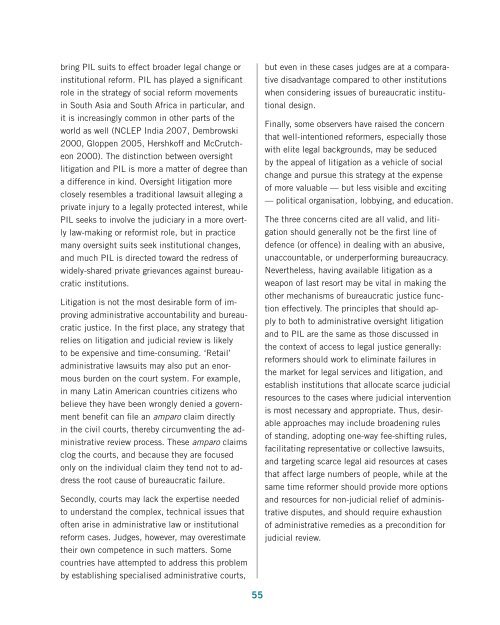Download the file - United Nations Rule of Law
Download the file - United Nations Rule of Law
Download the file - United Nations Rule of Law
You also want an ePaper? Increase the reach of your titles
YUMPU automatically turns print PDFs into web optimized ePapers that Google loves.
ing PIL suits to effect broader legal change orinstitutional reform. PIL has played a significantrole in <strong>the</strong> strategy <strong>of</strong> social reform movementsin South Asia and South Africa in particular, andit is increasingly common in o<strong>the</strong>r parts <strong>of</strong> <strong>the</strong>world as well (NCLEP India 2007, Dembrowski2000, Gloppen 2005, Hershk<strong>of</strong>f and McCrutcheon2000). The distinction between oversightlitigation and PIL is more a matter <strong>of</strong> degree thana difference in kind. Oversight litigation moreclosely resembles a traditional lawsuit alleging aprivate injury to a legally protected interest, whilePIL seeks to involve <strong>the</strong> judiciary in a more overtlylaw-making or reformist role, but in practicemany oversight suits seek institutional changes,and much PIL is directed toward <strong>the</strong> redress <strong>of</strong>widely-shared private grievances against bureaucraticinstitutions.Litigation is not <strong>the</strong> most desirable form <strong>of</strong> improvingadministrative accountability and bureaucraticjustice. In <strong>the</strong> first place, any strategy thatrelies on litigation and judicial review is likelyto be expensive and time-consuming. ‘Retail’administrative lawsuits may also put an enormousburden on <strong>the</strong> court system. For example,in many Latin American countries citizens whobelieve <strong>the</strong>y have been wrongly denied a governmentbenefit can <strong>file</strong> an amparo claim directlyin <strong>the</strong> civil courts, <strong>the</strong>reby circumventing <strong>the</strong> administrativereview process. These amparo claimsclog <strong>the</strong> courts, and because <strong>the</strong>y are focusedonly on <strong>the</strong> individual claim <strong>the</strong>y tend not to address<strong>the</strong> root cause <strong>of</strong> bureaucratic failure.Secondly, courts may lack <strong>the</strong> expertise neededto understand <strong>the</strong> complex, technical issues that<strong>of</strong>ten arise in administrative law or institutionalreform cases. Judges, however, may overestimate<strong>the</strong>ir own competence in such matters. Somecountries have attempted to address this problemby establishing specialised administrative courts,but even in <strong>the</strong>se cases judges are at a comparativedisadvantage compared to o<strong>the</strong>r institutionswhen considering issues <strong>of</strong> bureaucratic institutionaldesign.Finally, some observers have raised <strong>the</strong> concernthat well-intentioned reformers, especially thosewith elite legal backgrounds, may be seducedby <strong>the</strong> appeal <strong>of</strong> litigation as a vehicle <strong>of</strong> socialchange and pursue this strategy at <strong>the</strong> expense<strong>of</strong> more valuable — but less visible and exciting— political organisation, lobbying, and education.The three concerns cited are all valid, and litigationshould generally not be <strong>the</strong> first line <strong>of</strong>defence (or <strong>of</strong>fence) in dealing with an abusive,unaccountable, or underperforming bureaucracy.Never<strong>the</strong>less, having available litigation as aweapon <strong>of</strong> last resort may be vital in making <strong>the</strong>o<strong>the</strong>r mechanisms <strong>of</strong> bureaucratic justice functioneffectively. The principles that should applyto both to administrative oversight litigationand to PIL are <strong>the</strong> same as those discussed in<strong>the</strong> context <strong>of</strong> access to legal justice generally:reformers should work to eliminate failures in<strong>the</strong> market for legal services and litigation, andestablish institutions that allocate scarce judicialresources to <strong>the</strong> cases where judicial interventionis most necessary and appropriate. Thus, desirableapproaches may include broadening rules<strong>of</strong> standing, adopting one-way fee-shifting rules,facilitating representative or collective lawsuits,and targeting scarce legal aid resources at casesthat affect large numbers <strong>of</strong> people, while at <strong>the</strong>same time reformer should provide more optionsand resources for non-judicial relief <strong>of</strong> administrativedisputes, and should require exhaustion<strong>of</strong> administrative remedies as a precondition forjudicial review.55
















